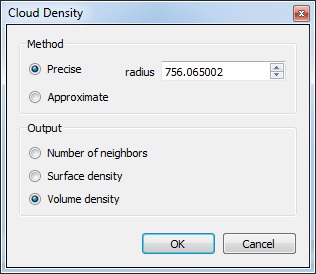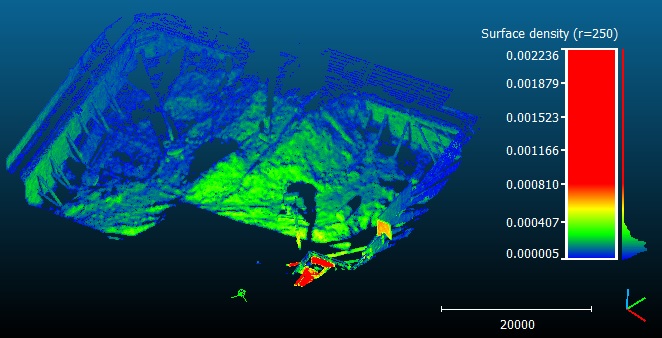Difference between revisions of "Density"
Jump to navigation
Jump to search
(→Output) |
(→Output) |
||
| Line 29: | Line 29: | ||
Notes: | Notes: | ||
* a point with no neighbor in the spherical neighborhood will have an invalid (''NaN'') density. | * a point with no neighbor in the spherical neighborhood will have an invalid (''NaN'') density. | ||
| − | * '''the central point is always used for computing the density''' (even when the output is the 'number of neighbors' as we consider the number of neighbors of the 'position in space' of each point). Therefore the density will be actually equal to | + | * '''the central point is always used for computing the density''' (even when the output is the 'number of neighbors' as we consider the number of neighbors of the 'position in space' of each point). Therefore the density will be actually equal to kNN + 1 where kNN is the number of neighbors of each point) |
Revision as of 13:21, 7 December 2017
Menu
This tool is accessible via the 'Tools > Other > Density' menu.
Description
This tool estimates the density of a point cloud.
Procedure
Select one or several point clouds then launch this tool.
A dialog will appear:
Precise or Approximate
Two methods can be used to compute the density:
- either 'Precise': the density is estimated by counting for each point the number of neighbors N (inside a sphere of radius R)
- or 'Approximate': the density is simply estimated by determining the distance to the nearest neighbor (which is generally much faster). This distance is considered as being equivalent to the above spherical neighborhood radius R (and N = 1).
Output
The density output can be:
- the number of neighbors N (only available in 'Precise' mode)
- a surface density: number of neighbors divided by the neighborhood surface = N / (Pi.R2)
- a volume density: number of neighbors divided by the neighborhood volume = N / (4/3.Pi.R3)
Notes:
- a point with no neighbor in the spherical neighborhood will have an invalid (NaN) density.
- the central point is always used for computing the density (even when the output is the 'number of neighbors' as we consider the number of neighbors of the 'position in space' of each point). Therefore the density will be actually equal to kNN + 1 where kNN is the number of neighbors of each point)

